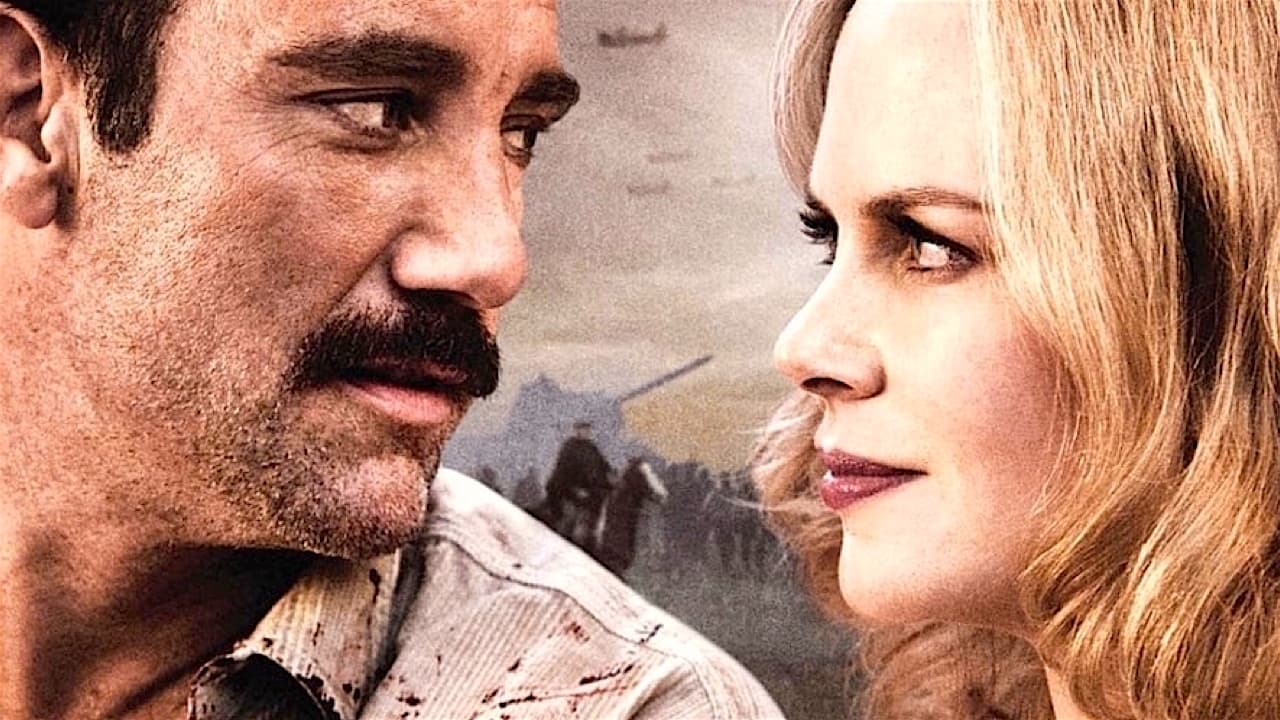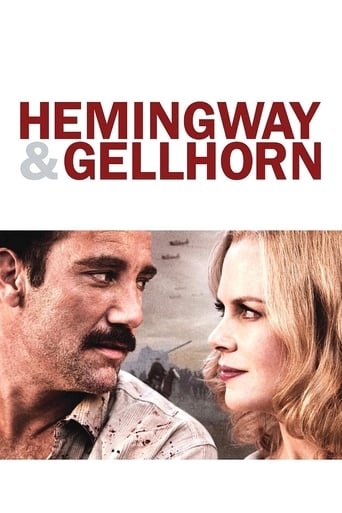

Philip Kaufman a writer and director known for making European art house cinema as well as populist films (he is the credited co- creator of the character Indian Jones.)This is an expensive, prestige HBO cable film that stars Clive Owen as Ernest Hemingway and Nicole Kidman as Martha Gellhorn that examines the relationship between the legendary adventurer and novelist and the budding war reporter. They travel together during the Spanish civil war and their adventures continue during the second world war which takes in the war in Europe and the far east.There is no doubt that Hemingway was a complex, boorish man. I once heard a remark: That he run out of things to shoot so he ended up shooting himself. Clive Owen never catches Hemingway to my liking, he is just too lightweight in the role.Kidman fares better as Gellhorn but she was a character I knew little about and the film is from her point of view as she was one of the first major female war reporters in the 20th century.The screenplay was bad and in some instances the movie is just laughable. There are plot lines that just hang in the air and never resolved. What was the deal between Paco and Rodrigo? How did Hemingway get a divorce when his staunch Catholic wife said she would never divorce him?Some actors like Robert Duval and Peter Coyote just pop in for a scene or two and then discarded along with story threads.The film blends archive footage where our characters are inserted into it. Some of it is done well but not all the time.The film does well in publicizing Gellhorn as a character but you learn little about Hemingway.
... View MoreThe production values on this TV movie are impeccable; expensively mounted sets, well-crafted costumes, and a clever use of technology that integrates the modern-day actors into archive film. This latter technique is especially good when it comes to showing Hemingway (Clive Owen) and Gellhorn (Nicole Kidman) and their involvement in the Spanish Civil War, and on their return to late Thirties New York. The main problem with Philip Kaufman's film, however, is the plot, which does not have much to say about the two protagonists, other than the fact that Hemingway's capacity to love women was often severely affected by his obsessive masculinity. The desire to prove himself triumphed over everything; it invaded every aspect of life, rendering him quite an unpleasant, if successful person. Gellhorn comes across as a feisty person, but we wonder precisely why she remains so attracted to Hemingway. Partly the fault lies in Clive Owen's performance; at no point does he come across as someone blessed with extraordinary creative talents. On the contrary he seems petty-minded, almost babyish. Nicole Kidman does what she can with a thankless role, but her performance remains studiously one-note. The film is at least an hour too long; it simply makes its central point about Hemingway's behavioral shortcomings over and over again. Definitely one to watch only once.
... View MoreEven though I'm a Hemingway fan and consider the man to be a personal hero, I would not be outraged if this movie were only a trashy, tell-all attack on the man himself. But there are so many things wrong with this confused, ugly mess other than the persistent sneering attacks on Papa.To understand the scope of the awfulness, you have to grasp all the things this movie promises and does not deliver. HEMINGWAY AND GELLHORN is not any of the following: 1. It is not an accurate picture of the Spanish Civil War or the rise of Fascism in Europe.2. It does not explain the motives or the values of American Communists either in the Abraham Lincoln Brigade or anywhere else.3. It does not establish Martha Gellhorn as a credible feminist hero or even a competent journalist.4. Although it represents Papa Hemingway as a bully, a woman beater, a liar, and a backstabber, it never tries to pinpoint the real nature of his illness, e.g. alcoholism or depression. We are merely told that he is a bad person over and over (and over) again.5. The complexities of Hemingway's code as a writer (as opposed to a tough guy, fighter and drinker) are completely ignored. His skepticism about art as propaganda is rejected out of hand as the result of greed or cowardice. There is no in-depth analysis of the real crimes of the Stalinists in Spain or elsewhere. Nor is Hemingway ever allowed to defend the idea of artistic truth as a force that transcends politics.6. While Martha Gellhorn is presented as a "feminist" in the story, she shows zero interest in helping other career women, and indeed spends all her time in the company of men. There is no indication that she wants women to unite for common goals, or that she recognizes any forms of injustice outside of her relationship with Hemingway.7. This is not a credible love story, there is no sexual passion between the male and female leads, nor any real evidence that they like each other as people.8. All of the period details are false and the film is visually ugly in a way that is blatantly artificial. The use of stock footage with Papa and Marty wandering through history hand-in-hand like Hansel and Gretel is so crudely, blatantly done that it almost seems like the film makers are putting you on, or pulling your leg. But it's all done very, very straight, in a somber style that screams to be taken seriously.9. Hemingway's drinking is obviously self-destructive, yet Martha matches him drink for drink without any sign of concern. And the old Martha chain-smokes in the excruciatingly self-promoting "interview" segments while moaning and groaning about how the world has let her down, without ever discussing dreary things like enabling her husband's alcoholism and how her own bad habits can lead to lung cancer.10. Why is this woman admirable? Why is her story important? Why? Why? Why?
... View MoreMy review title illustrates Martha Gellhorn's persistent complaint that her lifetime achievements as a war correspondent and writer merited more historical notoriety than simply being Hemingway's third wife. The title should have Gellhorn's name first, as the film begins and ends with her, without Hemingway. She outlived him by nearly 40 years, and thus had plenty of time to reflect on the significance of their time together. As Gellhorn notes: "A battlefield neither of us could survive was domestic life".(at least, together). They were too much alike in some ways, and yet different in some important ways, for their relationship to last forever. Gellhorn wrote that they were really afraid of each other, each being potentially the most violent person the other knew. Hemingway, being nearly a decade older and much better known by the public when they met, the relationship was bound to deteriorate as Gellman matured from a surrogate daughter and comrade in arms to being a true competitor of Hemingway in terms of taking on dangerous foreign adventures. Nonetheless, at the end of the film, where Gellman makes an imaginary phone call to a long deceased Hemingway, she grudgingly admits some debt to his influence on her life's work in the last line of the film "You're not dead yet, you f---."While the screenplay is mainly limited to the time when Gellhorn and Hemingway interacted with each other, the last portion skips ahead to the last weeks of Hemingway's life, when he's a chronically depressed white -haired old man of 61, undergoing ineffective ghastly electroshock treatments(which I was unaware of), before shooting himself as soon as he got back home. The near catatonic characterization of Hemingway at this time is probably an exaggeration. Just before his suicide, he mouths part of the speech he sent to Stockholm relating to his Nobel Prize, lamenting the typical fate of aging writers. Shortly before this segment, Hemingway is shown choosing to let his fishing line unravel when he hooks a marlin. This implies that he suddenly lost his will to deal with challenging situations and his ability to write effectively: a rather gross exaggeration of the truth. In fact, he continued to write prodigiously, even when seriously ill near the end of his life, and made a '54 trip to Africa. While dramatizing Gellman's activities on and shortly after D-day, the film ignores Hemingway's simultaneous post- D-Day-related activities. Hemingway's severe injuries from several plane accidents and development of several chronic health problems, which much contributed to his depressed state in his last decade, are ignored. The film ends with an unsuccessful attempt by reporters to get an aged Gellman to talk about Hemingway, followed by her imaginary phone conversion with the deceased, then with her exit for yet another foreign adventure.Nicole Kidman was fantastic as Gellhorn: occasionally romantic, but mostly hard-bitten and cynical with age, as a woman who led her chosen life would almost have to be. Gellhorn wrote that she didn't really enjoy sex and, in the film's beginning, says she was undoubtedly a very poor bed partner, that not being where her true passion lay. Hence, all the lovemaking scenes are initiated by Hemingway, often with a resisting Gellman.Clive Owen, as Hemingway, was a much less perfect fit, but still acceptable, for the most part. The details of their relationship and activities during this period apparently were carefully researched, according to the commentary by the director on my DVD copy. Frequent intermittent nesting of the principle actors into archival film footage relating to the various war zones gave an additional perception of authenticity. The frequent switching between B&W, semi-color and full color, which annoys some viewers, helped distinguish the past from the present, and nested archival footage from current scenes. Several lyrics to the tune for "Red River Valley" serves as the running theme song.The scene in which Hemmingway challenges Robert Duvall, as the Russian general, to a modified Russian roulette duel, is interesting. Each grasps the end of the same kerchief in the teeth and circle each other, as each holds a pistol to their head. The point of this bizarre ritual is not apparent before they are convinced to end it and hug each other. Could this represent a foreshadowing of the future Cold War, with nuclear arsenals being represented by the pistols? The initiation and termination of their intense relationship is symbolized by an adversarial conversation through her locked or partially open hotel room door, although their relationship actually began or effectively was terminated prior to these incidents.Their first sexual encounter is a very dramatic scene , as they writhe in ecstasy while the Madrid hotel room they occupy is gradually being destroyed by shock waves from fascist aerial bombs. Hemingway massages plaster dust from the crumbling ceiling over Gellhorn's skin. How many first sexual encounters are this dramatic? Later, as the two are backstage, waiting for Hemingway to be called out to introduce a documentary on the plight of Spanish peasants, he impulsively initiates standup sex with Gellhorn. Perhaps he hoped this would enhance his confidence in his speech, as is thought to have happened with JFK in his first presidential debate with Nixon. Gellhorn then makes a better follow up speech, but is ignored by the press.
... View More